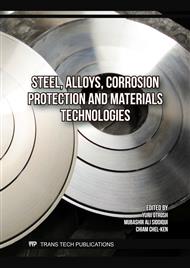[1]
A. Teslenko, A. Chernukha, O. Bezuglov, O. Bogatov, E. Kunitsa, V. Kalyna, A. Katunin, V. Kobzin, S. Minka, Construction of an algorithm for building regions of questionable decisions for devices containing gases in a linear multidimensional space of hazardous factors. Eastern-European Journal of Enterprise Technologies. 5/10 (101) (2019) 42–49.
DOI: 10.15587/1729-4061.2019.181668
Google Scholar
[2]
V. Sadkovyi, B. Pospelov, V. Andronov, E. Rybka, O. Krainiukov, A. Rud, K. Karpets, Y. Bezuhla, Construction of a method for detecting arbitrary hazard pollutants in the atmospheric air based on the structural function of the current pollutant concentrations. Eastern-European Journal of Enterprise Technologies. 6 (10) (2020) 14–22.
DOI: 10.15587/1729-4061.2020.218714
Google Scholar
[3]
B. Pospelov, E. Rybka, R. Meleshchenko, O. Krainiukov, S. Harbuz, Y. Bezuhla, I. Morozov, A. Kuruch, O. Saliyenko, R. Vasylchenko, Use of uncertainty function for identification of hazardous states of atmospheric pollution vector. Eastern-European Journal of Enterprise Technologies. 2/10 (2020) 6–12.
DOI: 10.15587/1729-4061.2020.200140
Google Scholar
[4]
O. Kulakov, A. Katunin, Ya. Kozhushko, S. Herasymov, О. Roianov, Т. Gorbach, Usage of Lidar Systems for Detection of Hazardous Substances in Various Weather Conditions, IEEE 6th International Symposium on Microwaves. Radar and Remote Sensing (MRRS). (2020) 360–363.
DOI: 10.1109/ukrmw49653.2020.9252783
Google Scholar
[5]
V. Sadkovyi, V. Andronov, O. Semkiv, A. Kovalov, E. Rybka, Y. Otrosh, M. Udianskyi, V. Koloskov, A. A. Danilin, P. Kovalov, Fire resistance of reinforced concrete and steel structures. Fire resistance of reinforced concrete and steel structures. (2021) 1–166.
DOI: 10.15587/978-617-7319-43-5
Google Scholar
[6]
A. Vasilchenko, Yu. Otrosh, N. N.Adamenko, E. Doronin, A. Kovalov, Feature of fire resistance calculation of steel structures with intumescent coating. MATEC Web of Conferences. 230 (2018) 02036.
DOI: 10.1051/matecconf/201823002036
Google Scholar
[7]
A. Chernukha, A. Teslenko, P. Kovaliov, O. Bezuglov, Mathematical modeling of fire-proof efficiency of coatings based on silicate composition. Materials Science Forum. 1006 (2020) 70–75.
DOI: 10.4028/www.scientific.net/msf.1006.70
Google Scholar
[8]
A. Katunin, O. Kolomiitsev, О. Kulakov, H. Heiko, I. Rudakov, Information technologies for calculating the effect of wire thickness and insulation material on its heating temperature during operation. IEEE 4th KhPI Week on Advanced Technology (KhPIWeek). (2023) 198–202.
DOI: 10.1109/khpiweek61412.2023.10311586
Google Scholar
[9]
O. Kulakov, M. Kustov, A. Katunin, O. Roianov, Investigation of the Impact Properties of the Material of the Isolation on the Parameters of the Loaded Cable Lines. Key Engineering Materials Submitted. 954 (2023) 125–133.
DOI: 10.4028/p-kyj7ky
Google Scholar
[10]
A.M. Katunin, O.V. Kulakov, S.V. Rudakov, S.V. Panasenko, Otsinka vplyvu strumu navantazhennia na temperaturu nahrivannia kabelnykh vyrobiv u protsesi ekspluatatsii. International Scientific Journal «Grail of Science». 24 (2023) 210–215 [in Ukrainian].
Google Scholar
[11]
A. Katunin, О. Kulakov, O. Roianov, Y. Mykhailovska, Investigation the Intensity of Heating of the Isolation Material of an Electrical Wire. Materials Science Forum Submitted. 1126 (2024) 143–150.
DOI: 10.4028/p-1q1wup
Google Scholar
[12]
A.P. Craknell, K.C. Wond, The Fermi surface. Its concept, determination, and use in the physics of metal. Clarendon press Oxford. (1973) 565.
Google Scholar
[13]
Pravyla ulashtuvannia elektroustanovok, Kyiv, 2017 [in Ukrainian].
Google Scholar


